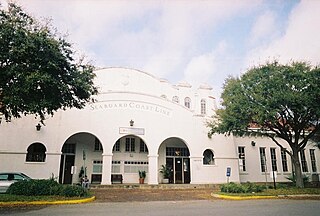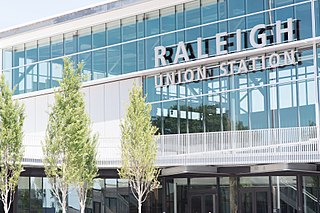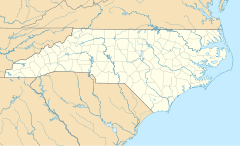
South Station, officially The Governor Michael S. Dukakis Transportation Center at South Station, is the largest railroad station and intercity bus terminal in Greater Boston and New England's second-largest transportation center after Logan International Airport. Located at the intersection of Atlantic Avenue and Summer Street in Dewey Square, Boston, Massachusetts, the historic station building was constructed in 1899 to replace the downtown terminals of several railroads. Today, it serves as a major intermodal domestic transportation hub, with service to the Greater Boston region and the Northeastern and Midwestern United States. It is used by thousands of commuter rail and intercity rail passengers daily. Connections to the rapid transit Red Line and bus rapid transit Silver Line are made through the adjacent subway station.

Orlando Health/Amtrak station, also known as Orlando station, is a train station in Orlando, Florida. It is served by Amtrak, the national railroad passenger system of the United States, and SunRail, the commuter rail service of Greater Orlando, as well as local and intercity buses. It serves Amtrak's Silver Meteor and Floridian lines. Built in 1926, the historic station is located in Downtown Orlando approximately one mile south of the central business district, near the campus of Orlando Health. Serving 160,442 passengers at last measure in 2013, The station is Amtrak's fifth busiest in the Southeastern United States; it is the second busiest Amtrak station in Florida, behind the Sanford station of the Auto Train.

Springfield Union Station is a train and bus station in the Metro Center area of Springfield, Massachusetts. Constructed in 1926, Springfield Union Station is the fifth-busiest Amtrak station in the Commonwealth, and the busiest outside of Greater Boston.

Doraville is a subway station in Doraville, Georgia, and the northern terminus on the Gold Line of the Metropolitan Atlanta Rapid Transit Authority (MARTA) rail system. Doraville serves as the ground for the Doraville rail yard for the Gold line, with a capacity of 30 rail cars.

Solana Beach Transit Center is a train station on Amtrak California's Pacific Surfliner passenger train and on North County Transit District's COASTER commuter rail route located in Solana Beach, California. The tracks were lowered to their current position in the late 90s, to alleviate congestion on Lomas Santa Fe Road and Downtown Solana Beach. There are two tracks that carry the Surf Line in a trench through the city of Solana Beach, including the station.

Gastonia station is an Amtrak train station in Gastonia, North Carolina, United States. Located at 350 Hancock Street, it is about 1.5 miles (2.4 km) northeast of downtown Gastonia.

Charlotte station is an Amtrak station located at 1914 North Tryon Street, about 1.5 miles (2.4 km) to the northeast of Uptown Charlotte. Owned by Norfolk Southern, it is located near that railroad's yard outside Uptown.

High Point station is an intermodal transit station in High Point, North Carolina, United States. Its main building serves as an Amtrak train station, while the Broad Avenue Terminal serves as the bus terminus for both High Point Transit System (HPTS) and the Piedmont Authority for Regional Transportation (PART). The station is located in downtown High Point and near the West High Street Historic District.

J. Douglas Galyon Depot, also known as Greensboro station, is an intermodal transit facility in Greensboro, North Carolina. Located at 236 East Washington Street in downtown Greensboro, it serves Amtrak passenger rail and is the city's main hub for local and intercity buses.

Kannapolis station is an Amtrak train station in Kannapolis, North Carolina, United States. It is located at 201 South Main Street, within walking distance of Atrium Health Ballpark and the North Carolina Research Campus, in downtown Kannapolis.

Selma Union Depot, also known as Selma Union Station and Selma–Smithfield, is a train station and museum in Selma, North Carolina, and near the town of Smithfield. Built in 1924, it is currently served by two Amtrak passenger trains, the Palmetto and the Carolinian. It is located at 500 East Railroad Street in the heart of downtown Selma. The Floridian and the Silver Meteor have their northern split here, but do not stop in Selma.

G.K. Butterfield Train Station, also known as Wilson station, is an Amtrak train station in Wilson, North Carolina, United States. It is located in downtown Wilson and is part of the Wilson Central Business–Tobacco Warehouse Historic District.
The North Charleston Intermodal Transportation Center is an intermodal transit station in North Charleston, South Carolina, United States. It serves as the Amtrak train station for the Greater Charleston area as well as a bus terminus for the Charleston Area Regional Transportation Authority (CARTA) and Southeastern Stages, a regional intercity bus common carrier. The street address is 4565 Gaynor Avenue, and is located in the Liberty Hill neighborhood. The station appears in Amtrak timetables as Charleston.

Raleigh Union Station is an intermodal transit station in Raleigh, North Carolina, United States. Train service began the morning of July 10, 2018. Its main building serves as an Amtrak train station, while a future adjacent building will serve as the bus terminus for GoTriangle. The station is located at the Boylan Wye, a railroad junction used by CSX and Norfolk Southern, and adjacent to the Depot Historic District in downtown Raleigh.

The Goldsboro Union Station is a former passenger train depot and future intermodal transit station in Goldsboro, North Carolina, United States. Originally operating from 1909 to 1968, the Eclectic two-story brick depot was preserved as one of the most ambitious railroad structures in North Carolina, built as a symbol of the importance of railroading to Goldsboro. Currently closed-off for future renovations, the five-acre (2.0 ha) facility also includes the GWTA Bus Transfer Center.

Charlotte Gateway Station is a future intermodal transit station in Charlotte, North Carolina, United States. Currently operating as a streetcar stop for the CityLynx Gold Line, with an adjoining bus station for Greyhound Lines intercity buses, it is the centerpiece of the overall 19-acre (7.7 ha) Station District, and it will serve Charlotte Area Transit System (CATS) bus lines, the Lynx Silver Line light rail, and Amtrak intercity trains. The district will also include parking facilities, mixed-use development and an elevated greenway. Estimated at a cost of $800.1 million for full implementation of all public and private components, the project will be built in three phases, with Amtrak service tentatively scheduled to start in 2026–2027.
There are many different types of transportation in North Carolina, including air, rail, mass transit, and major highways. North Carolina is a rapidly growing state with over 10.4 million people and requires multiple types of transportation. Currently, NC has 10 commercial and many municipal airports, a passenger rail called NC By Train operated by North Carolina in partnership with Amtrak with many different routes, public bus transportation in cities like Raleigh and Charlotte, and highways that span the State.

Joseph Florence Leitner was an American architect whose work includes several rail stations. In Columbia, South Carolina he worked for Charles Coker Wilson for five years. Later he partnered with William J. Wilkins (architect), first in Florence, South Carolina and then in an office in Wilmington, North Carolina, where Leitner practiced for a decade. to form Leitner & Wilkins. His work included commercial, educational, fraternal religious, industrial, residential, and transportation buildings in colonial revival architecture, Flemish architecture (especially gables, Italianate architecture and Romanesque revival architecture styles. He ended his career in Florida.

NC By Train is a brand name used by the Rail Division of the North Carolina Department of Transportation (NCDOT) for two state-supported Amtrak routes operating in the U.S. state of North Carolina–the Carolinian and the Piedmont.

Wilmington Union Station was a union station in Wilmington, North Carolina. Opened in 1913, it was designed by architect Joseph F. Leitner. Construction by Boyle-Robertson contractors began in 1912. It was located at Front Street and Red Cross Street in downtown Wilmington.





















